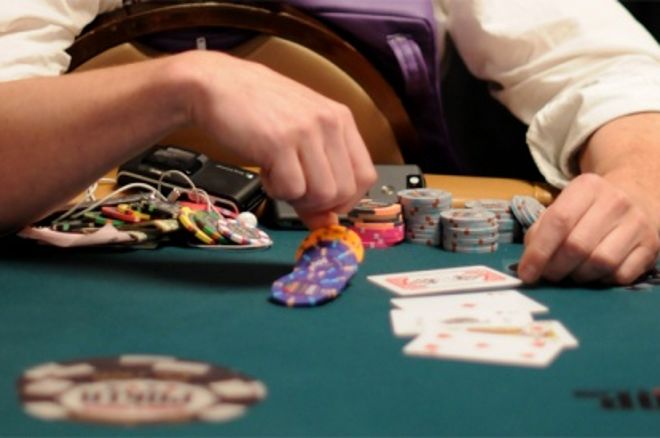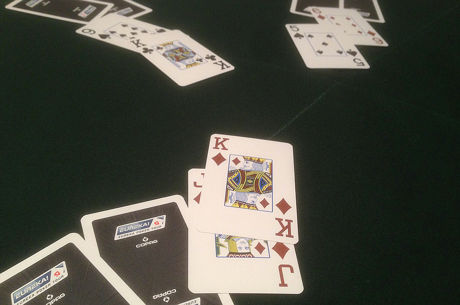WSOP Preparation: Stud Strategy - Why Aggression Makes Sense

The 2017 World Series of Poker is nearly upon us, and with it comes an opportunity to play games other than no-limit hold'em or pot-limit Omaha.
This time of year in Las Vegas brings out the stud games �� specifically seven-card stud, seven-card stud hi-low eight-or-better, and razz.
Each of these stud games have their own tournaments on the WSOP schedule while also being part of multi-game events like H.O.R.S.E and the 8-game mix. Stud games additionally turn up as part of other events like the Omaha Hi-Low/Stud Hi-Low mix and Dealer's Choice. You're also likely to find decent cash game action at the Rio All-Suite Hotel and Casino, though it tends to be at $30/$60 limits and above.
There are many advantages to playing stud games, even if you're not an expert. First of all, the tournament fields tend to be considerably smaller than the monster fields of most of the NLHE and PLO events, giving the solid stud player a better chance of finishing in the money or taking down the ultimate prize.
Also, since so few players are experts at stud these days �� not being able to make a living at it any longer because of the relative paucity of games �� you'll often find yourself up against many players who really don't know what they're doing. In many instances they will be home game players, figuring that since they have played stud in their home game, they'll play it in a big tournament.
But the casino stud game �� and especially the tournament game �� is quite different from the home game. If you do know what you're doing, and can make the necessary adjustments for this different setting, you'll have a decided advantage.
Accordingly, in the interest of helping you improve your stud game, in the weeks to come I'll be providing some strategy articles on the subject in time for start of the WSOP in late May. A theme I'm going to promote early on is the advantages of being aggressive in these WSOP stud events, starting today with a discussion of why it pays to be aggressive right off the bat once the cards are dealt.
One chief difference between WSOP stud tournaments and stud as it is played in typical cash games or home games is that in the WSOP tournaments, the antes and forced bets create a much larger initial pot relative to the size of the initial bet. Your strategy must adapt to this essential difference. Simply put, you must be more aggressive in your efforts to win that initial pot, as your attempts to steal will be better rewarded.
In a typical low- or middle-stakes cash stud game, the antes and forced bets typically make up something slightly larger than the lower tier of betting. For example, you wager $5 to win $6 in $5/$10, $10 to win $11 in $10/$20 and $20 to win $29 in $20/$40. In a home game you're most likely winning even less for the same wager, since the initial pot probably won't have the benefit of a forced bet which many home games don't require.
Compare this to the ratio of initial bet to pot in the $1,500 stud tournament. The first betting level of the tournament �� $100/$200 �� feature $25 antes and a $25 forced bet. You wager $100 to win $225 (!). Move up to a middle level of the tournament and we find the $1,000/$2,000 level has a $200 ante and a $300 forced bet for an initial pot of $1,900. That's a $1,000 bet to win a pot of $1,900.
Here are a few quick charts to illustrate more clearly how the stakes affect pot sizes:
WSOP TOURNAMENT
| Level | Ante | Forced Bet | Pot Size to Bet | Ratio |
|---|---|---|---|---|
| $100/$200 | $25 | $25 | $225 to $100 | 2.25-to-1 |
| $1,000/$2,000 | $200 | $300 | $1,900 to $1,000 | 1.9-to-1 |
CASH GAME
| Level | Ante | Forced Bet | Pot Size to Bet | Ratio |
|---|---|---|---|---|
| $5/$10 | $0.50 | $2 | $6 to $5 | 1.2-to-1 |
| $10/$20 | $1 | $3 | $11 to $10 | 1.1-to-1 |
| $20/$40 | $3 | $5 | $29 to $20 | 1.45-to-1 |
HOME GAME
| Level | Ante | Forced Bet | Pot Size to Bet | Ratio |
|---|---|---|---|---|
| $10/$20 | $1 | none | $8 to $10 | 0.8-to-1 |
How does knowing this change your strategy? First of all, consider the risk versus the reward.
What's the reward if you attempt to steal the antes and forced bets? All other factors being equal, the more you gain for your risk, the more inclined you should be to take that risk.
If you're risking $100 to win $225, you don't have to be successful as frequently as if you're risking $10 to win $11. In short, in these tournaments it pays to be more aggressive than you might be in a cash game or home game, since you don't have to win as often for the bet to pay off in the long run.
There's another reason to heighten your aggression in these WSOP stud tournaments. While some who play them will be well-versed in stud, a decent number will not be especially confident in their stud game, making them risk-averse.
Such players often will rather concede to pressure than soldier on in a contest. They figure that though they know how to play stud, they are not experienced enough to take unnecessary risks. By just waiting for big hands, they reason that they can lessen the risks and outlast some of the more aggressive players.
This is flawed thinking, of course. An optimal strategy means adjusting your play to suit the circumstances in which you find yourself. Tight is not always right, even if it appears the safest option.
As the antes and forced bets increase, the stack of the unduly tight player, in the interest of conserving chips, will be frittered away. Without regularly fighting for those antes and blinds, such players will be missing opportunities to grow their stacks to a level necessary to keep up with the increasing costs.
Your aggression will take advantage of these players' tendencies toward tightness while also enabling you to steal your fair share of those engorged early pots. Similarly, it will help you if you can apply your aggression to steal pots as the hand progresses.
In my next column, we'll look at a few other aggressive moves you can make on third street.
Ashley Adams has been playing poker for 50 years and writing about it since 2000. He is the author of hundreds of articles and two books, Winning 7-Card Stud (Kensington 2003) and Winning No-Limit Hold'em (Lighthouse 2012). He is also the host of poker radio show House of Cards. See www.houseofcardsradio.com for broadcast times, stations, and podcasts.









